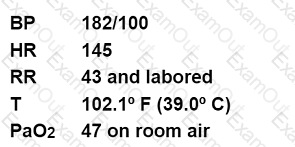The intended effects of medications for a patient in acute CHF are to
Which of the following is a sign of splenic injury and diaphragmatic irritation?
Treatment of cerebral vasospasm includes administration of
The family member of a patient who is receiving mechanical ventilation is to be taught suctioning. When developing a teaching plan, the nurse should first
In a patient with a chest tube, an air leak in the pleural space is indicated by which of the following conditions in the water-seal chamber?
A patient with an acute anterior wall MI presents with an S3 gallop and the following values:

Which drug therapy would be most appropriate for this patient?
Which of the following intubated patients is most at risk for developing ventilator-associated pneumonia (VAP)?
A patient is admitted with a femoral shaft fracture and an oblique fracture of three ribs on the right side. The patient suddenly reports shortness of breath. Assessment reveals new-onset headache, central and peripheral cyanosis, and petechiae of the neck and anterior chest wall. Available data are:

The nurse should suspect the development of
While recording hourly ventilator checks on a patient who is being mechanically ventilated, the nurse notes that the PIP has gradually increased by 5 cm H2O over the past 4 hours. This increase indicates
The nurse who is caring for a patient following an esophagectomy notes new subcutaneous emphysema in the upper chest and neck. The nurse should expect an order for

